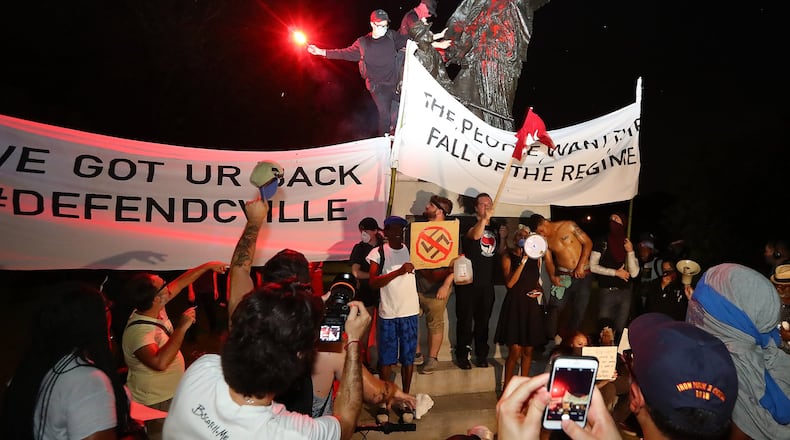President Donald Trump doubled down Tuesday on his “many sides” take on Charlottesville, casting equal blame for violence associated with the racist “Unite The Right” rally on the neo-Nazi’s and “troublemakers” on the other side.
“Now, in the other group also, you had some fine people, but you also had troublemakers, and you see them come with the black outfits and with the helmets and with the baseball bats,” the president said. “You had a lot of bad people in the other group too.”
Much to the delight white supremacist and white nationalist leaders, Trump appeared to be referring to anti-fascist activists, sometimes known as “antifa,” that are a small but easily identifiable part of the counter-protest movement.
So, who are these “troublemakers” and what do they want?
In an exclusive interview, I spoke with two members of the Atlanta Antifascists, an anonymous collective of racial activists who have dedicated themselves to confronting the alt-right at every turn.
“The alt-right has a cultural strategy. It’s trying to change what values are appropriate in the broader culture,” one of them told me. “We think presenting genuinely anti-racists voices is important.”
The two men I spoke with are white millennials. One came to activism from the punk rock scene, while the other younger man appeared to be more in tune with online community of activists. They were quiet, somewhat bookish men who were cautious about sharing their unvarnished opinions with a card-carrying member of the mainstream media.
They asked not to have their names published, in part because they fear violence from white nationalist activists and reprisals from the authorities. I agreed, much in the same way I have done when interviewing activists from the extreme right.
But before David Duke starts celebrating, I'm not suggesting antifascists are the same as white nationalists.
Duke, Richard Spencer and their fellow travelers are actively seeking the creation of a white "ethnostate." Like their Nazi forefathers, they subscribe to the belief that whites are culturally and (depending on the speaker) genetically superior to blacks and Jews.
For nearly a century, those views have been considered beyond the pale on the American political scene.
‘Violence in self-defense’
The antifa are the masked and hooded fellows among the hundreds of counter-protesters who disrupted a white supremacist rally at Stone Mountain in 2016, setting fires and throwing rocks at the police who kept the two sides apart. A year later, they were in Auburn, Ala., to protest an appearance by Spencer.
And they were downtown Sunday when a broad coalition of activists convened at Woodruff Park to express their outrage at the killing of a woman and the wounding of 19 more in Charlottesville when an alt-right sympathizer rammed into a crowd of counter protesters.
Of the hundreds of protesters in Atlanta last weekend, the antifa element appeared to number in the low single digits. But, boy, they are loud.
They also are political radicals — including some socialists, anarchists, communists — and their tactics cause some who would be natural allies to squirm. For instance, theirs isn't a nonviolent movement, as the famous video clip of Spencer getting socked in the jaw on Inauguration Day would indicate.
Video clips emerging from Charlottesville show alt-right protesters, often armed with homemade riot shields and clubs, doing battle with black-hooded and masked antifa counter protesters, some of whom have crude weapons of their own. Social media traffic commenting on the action would have one believe that staging such a confrontation was an ultimate goal of the rally in the first place.
One of the antifa representatives I talked to acknowledged an “ongoing tension” over physically confronting alt-right activists.
“There are those who think physical force can be morally and politically justified. We are in that camp,” he said. “Violence in self-defense is justified.”
At the same time, he said the activists don’t think they can “out-violence the right.”
“Do we think that is a viable strategy?” he said. “In general, that doesn’t seem realistic.”
Even without adopting a traditional non-violent approach, the men I spoke to dismissed the president’s “all sides” theory on Charlottesville. It’s a false equivalence, they said.
The alt-right is trying to normalize race-based politics. The antifascists are reacting to that effort with protests, both online and in real life, but they will defend themselves, he said.
“We are not going to tell these people, ‘Use moral force against that knife,’” one said. “There is a difference between responding with physical force to someone whose stated policy is your extermination.”
Confrontation in Piedmont Park
All well and good in theory, but in reality antifa activism has an outsized impact on the protests against the alt-right. Take Sunday’s march in downtown Atlanta as an example.
Toward the end of what had been a peaceful, if boisterous, rally, several hundred anti-racist protesters gathered around a monument in Piedmont Park known as the “Peace Statue.”
The statue, which depicts an angel laying its hand on a Confederate soldier laying down his rifle, was chosen as a destination for the march to connect the protest with Charlottesville. In that city, racist activists rallied, ostensibly, over their own outrage that such Confederate symbolism was under attack.
While hundreds of non-antifa protesters gathered to hear speakers, two young, white men in dark clothing and masks climbed statue and began spray painting it and threatening to tear it apart. They might have done it too, if one of them happened to have a backhoe in his pocket.
Throughout the event, police had kept their distance from the protesters, but the threat to the statue prompted Maj. Timothy Peek, a 24-year veteran of the Atlanta Police Department, to wade into the crowd.
Peek quickly was surrounded by a dozen or so antifa activists, who began yelling and crowding him.
“Blue lives splatter,” some in the group chanted, with one calling him a “waste of (expletive) oxygen.”
The group became so loud and threatening, a black woman with a bullhorn, who was part of the protest but not antifa, physically inserted herself between the activists and the officer. “He’s got kids!” she said.
The moment passed and an antifa protester who had been on the perimeter of the scrum addressed his comrades with some practical advice.
“Let’s move on,” he said. “This isn’t a good look.”
No, it wasn’t. Two days later, the activists I spoke with were reflective, if not apologetic.
They do view police as a tool of an establishment they want to dismantle. However, they said they do “have to take responsibility that there may be chaotic situations.”
“I think that (Sunday protest) was for people who were feeling a pretty profound rage,” one told me.
That rage is fuel for the “many sides” debate we will be reading and hearing about in the months to come.
About the Author
Keep Reading
The Latest
Featured





